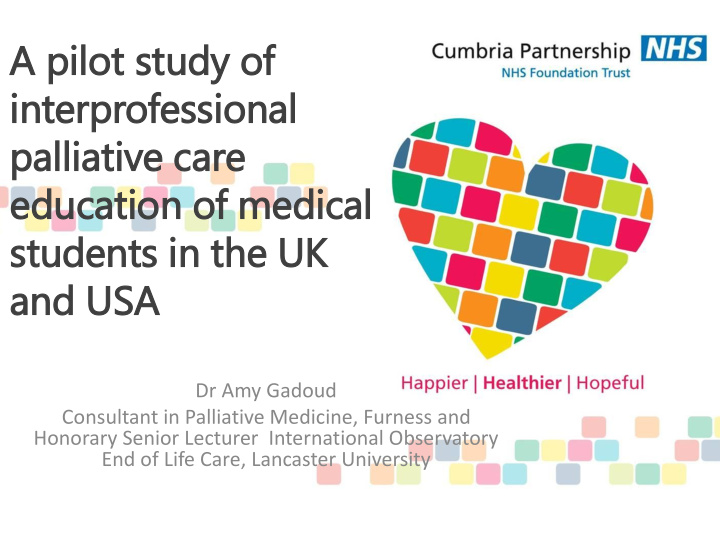



A pil ilot stu tudy of in interprofessional pall lliative care education of medical stu tudents in in th the UK and and USA Dr Amy Gadoud Consultant in Palliative Medicine, Furness and Honorary Senior Lecturer International Observatory End of Life Care, Lancaster University
Co authors • Dr Wei-Hsin Lu, Dr Lisa Strano-Paul, Dr Susan Stony Brook Medical School, New York, USA • Dr Jason W Boland, Hull York Medical School
Conception!
“It's Not All Doom and Gloom”: Perceptions of Medical Students Talking to Hospice Patients Amy Gadoud, Yousef Adcock, Lesley Jones, Sim Koon, and Miriam Johnson. Journal of Palliative Medicine. September 2013, 16(9): 1125-1129. https://doi.org/10.1089/jpm.2013.0036 Impact of a home Hospice Visit Program on Third-Year Medical students: a qualitative analysis of student reflections Lisa Strano-Paul, Susan Lane, Wei-Hsin Lu and Latha Chandran J Palliat Care 2015;31:5 – 12
Background • This audience knows the importance of educating medical students re pall care • Traditionally, medical student programmes are run by doctors, but patient care is delivered by an interprofessional team • Our programmes in the UK and USA independently developed a teaching experience led by an interprofessional team of palliative care health professionals.
Aim Explore the palliative care health professionals’ perceptions, regarding their unique role in medical student palliative care education
Method • Focus groups (3 UK sites) and 1 US • Non-medical palliative care health professionals (NMPCHPs)!! • Involved in medical student teaching • Semi structured (topic guide) • Thematic analysis
Context • US Home visits either to patient’s residence or assisted living facility (half day day) facilitated by hospice nurses • UK variable but at least 2 half days faciltated by NMPCHPs in patients home or elsewhere • As part of wider programme see paper for detais
Findings • Comparison across sites (UK and US) were strikingly similar • Two main themes 1. Perceived benefits and value of the experience and the NMPCHPs contributions to the experience 2. The challenges and limitations of the experiences with suggestions for overcoming these challenges
Perceived benefits and value of the experience • Provides a different perspective of palliative care Some students are very surprised that death and dying occurs in the home… (US site)
Perceived benefits and value of the experience • Provides a greater understanding of the significance of interprofessional teams These experiences offer medical students the opportunity to appreciate each profession’s unique contributions to patient care.
Perceived benefits and value of the experience • Gives patients a feeling of importance and opportunity to contribute The majority of patients love when the medical students come, they love to tell their stories and to have somebody sit there listening to them… (US site)
Challenges and limitations of the experience • Readiness and interest of medical students Not emotionally prepared to see a dying patient Rare instances of students demonstrating a lack of enthusiasm by ‘ yawning all the time ’ and ‘ showing no interest by slouching in every patient’s house ’. However, the nurses had mechanisms for dealing with this, for example using a little humour ‘… yawning is okay but if you start snoring I am not going to be very happy ’ (UK site 3).
Challenges and limitations of the experience • Concerns about patients feeling overwhelmed and expressing reservation I think to say to a patient ‘do you mind if I bring a medical student’ is not very empowering to say no so I say ‘I can come on this particular day with a medical students or I can come on another day and I’ll be on my own’ and then they choose and a lot will say ‘Oh no I’m quite happy for you to bring a medical student with you.’ (UK site 1)
Challenges and limitations of the experience • Lack of structure and the need for closing the feedback loop I think if we could get clearer outcomes…but its knowing what they’re expecting to get from this and feedback afterwards because…I don’t know whether we’re doing right or wrong. (UK site 1)
Strengths • This is the first study to ascertain views of an interprofessional team delivering palliative care education to medical student • Two countries improving generalisability of the findings
Limitations • Students ’ experiences at the different sites were relatively short and different • The focus group facilitator at the US site was involved with running the programme • We sought to obtain the perceptions of a range of non-medical professionals; however, the majority of professionals were nurses
Conclusions • Despite different structures and settings, this experiential learning in palliative care provided a rewarding interprofessional experience that has historically been difficult to achieve
References Gadoud, A., Lu, W-H., Strano-Paul, L., Lane, S. & Boland, J. W A pilot study of interprofessional palliative care education of medical students in the UK and USA BMJ Supportive and Palliative Care (epub ahead of print) Boland, J. W., Dikomitis, L. & Gadoud, A. Medical students writing on death, dying and palliative care: a qualitative analysis of reflective essays BMJ Supportive and Palliative Care. 6, p. 486-492 7 Arolker M, Barnes J, Gadoud A Jones L, Barnes L, Johnson M “They’ve got to learn” – A qualitative study exploring the views of patients and staff regarding medical student teaching in a hospice Palliative Medicine 2010; 24(4):419-426 Gadoud A, Jones L, Johnson M, Adcock Y, Arolker M, Barnes J. Medical students talking to hospice patients. The Clinical Teacher. 2012; 9(1):9-13. Gadoud A, Adcock Y, Jones L, Koon S, Johnson M. Its not all doom and gloom”: Perceptions of medical students talking to hospice patients. Journal of Palliative Medicine. 2013; 16(9):1125-9.
Thank you • Any questions?
Recommend
More recommend